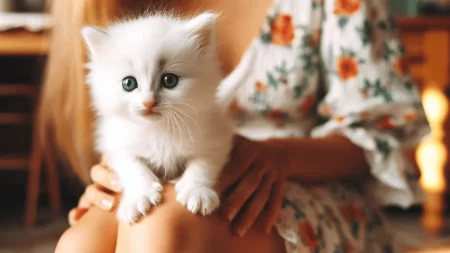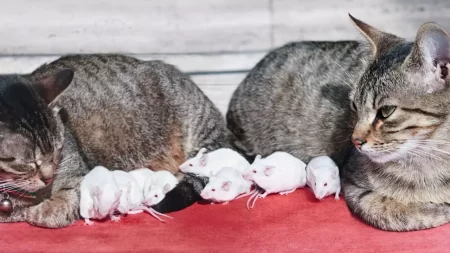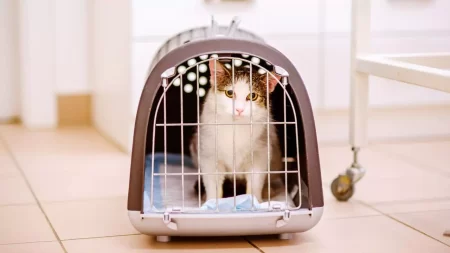Do cats always respond when you meow? You may want to know how they react. This article will show you. From purrs to swats, learn the cats’ reactions to meowing. Prepare for an exciting and educational adventure into the realm of cats and communication!
Do people ponder what takes place when they “meow” at a cat?
Cats are usually considered mysterious animals. A few cats may not care about human sounds, yet others could react with vocalizations or body language. To figure out how a cat will react to your meows, comprehend why cats meow in the first place—and why they might respond to you.
What is a Meow?
Meow is vocalization cats use. It can mean various things like pleasure, pain, anger, or a threat. Cats may meow to get attention from their owners or other cats. Other times, cats meow when they are feeling affectionate or socializing.
Furthermore, the meow can be a sign of submission in an altercation or if a cat is cornered by a predator. Remember, when you meow at a cat, it won’t mean the same as when humans talk. Your meows just show you are trying to communicate. This may lead to further interaction with the cat.
How Do Cats Respond to Meows?
Cats meow to communicate with us. They could be telling us they’re hungry, tired, bored or just feeling playful. They expect us to react. So many feline behaviors are actually for humans. When we meow back, our cats appreciate it and view us as equals, not just members of the family.
Cats use different sounds and body language to talk to each other. For example, head rubbing, blinking, and hissing. When we meow back, what should we expect? Generally, a short meow or chirp means your kitty wants more conversation or attention. Silence could mean they’re content or don’t want to talk.
Cats are observant. They understand subtle cues including tones of voice. If you meow in a friendly tone, they’ll usually respond positively and carry on the conversation. Some cats are more vocal than others. Remember, felines have different preferences when it comes to communication.
The Meaning of Different Meows
Cat’s meow, chirp, cry, and purr to communicate. Meows are the most common type of sound they make. They can indicate various needs or feelings. Knowing the different meows can help you understand your cat.
Happy and greeting meows are short and often combined with tail flicking. Plea meows are longer and higher pitched. They occur when cats want something like food or access to another room.
Commanding meows are deeper. They happen when cats want something from humans. Or, when they assert dominance over another animal. If this happens, it’s best for owners to calmly show they are the leader. This sets boundaries and results in successful living together.
How Do Cats Communicate with Humans?
Cats don’t talk like us, but they have their own way of communicating. They make strong bonds with people. To get attention, cats use vocalizing and body language. They meow when they want something, like food or attention. They purr when they are happy.
Cats are usually quiet, but they make distinct sounds. If you meow at a cat, it will probably stare at you, confused, then wander away in search of something more exciting than a weird human!
What Does It Mean When a Cat Meows at You?
Cats meow to tell us different things. Like if they are hungry, want attention, or are feeling territorial. Older cats often meow more for affection.
The sound of the meow can mean different things. A small quiet one might mean contentment. But a loud one could be a sign of anger. It is hard to know what the meow means just by hearing it.
Our cats won’t understand if we meow back. Human language and animal sounds are very different. But if your cat seems interested in the sound, they may be mimicking you. Or maybe they just find it interesting!
How to Interpret Your Cat’s Meows
Cats meow for many reasons – hello, to get something, or to alert you to a problem. Knowing the meows can be hard. Here’s how to decipher them:
● Check volume and length – cats use these to send messages. A high-pitched and long meow might mean distress. A low meow could mean contentment.
● Observe body language – cats can do a headbutt or bumble. These signs can help you understand what they want.
● Respond accordingly – cats like it when you try to understand them. Show enthusiasm if they come close. Comfort them if they seem nervous. Talk softly if they’re content. Ask questions if curious. Play with them if bored!
By understanding cat communication – including their meows – you can better understand your furry friend and form a closer bond!
Conclusion
Cats seem to understand meowing when it comes from other cats. But, they generally don’t respond when it comes from humans. Still, some cats will meow back if their humans meow at them. This could mean cats don’t necessarily think of human meowing as a language but as another way of communicating, like purring. Each cat is unique, so if you want to meow at yours, why not give it a try and see what happens?




![What Happens If You Meow to a Cat? [Uncovering the Mystery] What happens if you meow to a cat](https://justcatlover.com/wp-content/uploads/2023/02/What-happens-if-you-meow-to-a-cat-1024x576.jpg)


